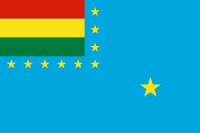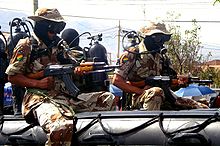- Bolivian Naval Force
-
The Bolivian Naval Force (Spanish: Fuerza Naval Boliviana), formerly known as the Bolivian Navy (Armada Boliviana) is a branch of the Bolivian Armed Forces. As of 2008, the Bolivian Naval Force had approximately 5,000 personnel.[1] Although Bolivia has been landlocked since the War of the Pacific in 1879, Bolivia established a River and Lake Force (Fuerza Fluvial y Lacustre) in January 1963 under the Ministry of National Defense. It consisted of four boats supplied from the United States and 1,800 personnel recruited largely from the Bolivian Army. The Bolivian Navy was renamed as the Bolivian Naval Force (Fuerza Naval Boliviana) in January 1966, but it has since been called the Bolivian Navy (Armada Boliviana) as well. It became a separate branch of the armed forces in 1963. Bolivia has large rivers which are tributaries to the Amazon which are patrolled to prevent smuggling and drug trafficking. Bolivia also maintains a naval presence on Lake Titicaca, the highest navigable lake in the world, across which runs the Peruvian frontier.
Landlocked Bolivia has not reconciled with the loss of its coast to Chile and the Navy exists to keep the hope alive of recovering its coast by cultivating a maritime consciousness.[2] The Bolivian Navy takes part in many parades and government functions, but none more so than the Día Del Mar (Day of the Sea) in which Bolivia, every year, asks for the coast territories lost to Chile during the War of the Pacific which was fought between Peru and Bolivia against Chile from 1879 to 1884. The reconquest of its coastline is a point of honor for Bolivia, influencing many modern day political actions and trade decisions.
Contents
Organization
The Navy is organized into ten naval districts with flotilla headquarters in Guaqui, Guayaramerín, Puerto Suarez, Riberalta, and San Pedro de Tiquina and bases in Puerto Busch, Puerto Horquilla, Puerto Villarroel, Trinidad, and Rurrenabaque.
Naval vessels include several dozen boats, a dozen or more of which are for riverine patrol. Seagoing vessels, including the American-made PR-51 Santa Cruz de la Sierra and several other vessels sail the oceans with the Bolivian flag with the granted permission of the "Capitanias Navales" Naval Registration Office. The Libertador Simón Bolívar, a ship acquired from Venezuela, used to sail from its home port in Rosario, Argentina on the River Paraná. In 1993 the Navy was formally renamed the Naval Force (Fuerza Naval) and moved with the Bolivian Army under a single military authority.
Most of the officers attend the Bolivian Naval Academy, graduating with a Bachelor of Science in Military and Naval Science, accredited by the Military University. Many naval officers later go onto to further studies on the undergraduate and graduate level. Argentina's Naval Military Group in Bolivia advises on naval strategy and tactics. Many Bolivian officers train in ocean sailing on Argentinian seagoing naval ships. The Force has several Special Operations units to address both internal and external threats. The Force covers the extensive Bolivian inland waterways divided between the following Naval Districts, named after the basin or region where they operate:
-
- DN1 First Naval District "BENI" —— (DN1 Primer Distrito Naval "BENI")
- DN2 Second Naval District "MAMORA" —— (DN2 Segundo Distrito Naval- "MAMORE")
- DN3 Third Naval District "MADERA" —— (DN3 Tercer Distrito Naval "MADERA")
- DN4 Fourth Naval District "TITICACA" —— (DN4 Cuarto Distrito Naval "TITICACA")
- DN5 Fifth Naval District "SANTA CRUZ DE LA SIERRA" —— (DN5 Quinto Distrito Naval "SANTA CRUZ DE LA SIERRA")
- Sixth Naval District DN6 "COBIJA" —— (DN6 Sexto Distrito Naval "COBIJA")
-
- The Naval Service Areas:
-
-
- AN 1 "COCHABAMBA" —— (AN 1 "COCHABAMBA")
- AN 2 "SANTA CRUZ" —— (AN 2 "SANTA CRUZ")
- AN 3 "BERMEJO" —— (AN 3 "BERMEJO")
- AN 4 "LA PAZ" —— (AN 4 "LA PAZ")
-
-
- Special Operation capable units:
-
-
- Task Force "Blue Devils" —— (Fuerza de Tarea "Diablos Azules)
- SINDA Naval Intelligence Service of the Bolivian Navy —— (Servicio de Inteligencia Naval)
- Immediate Response Group GRIN —— (Grupo de Reacción Inmediata GRIN)
- The High Altitude Diving Training Center —— (El Centro de Instrucción de Buceo en Altura)
- Command Training Center Amphibians
-
Marine Corps
The Marine component of the FNB originated with the creation of the Marine Battalion Almirante Grau in the early 1980s. This force consists of 600 men is based on Tiquina Naval Base on Lake Titicaca. Later changes name to Marine Battalion Independence, based in Chua (Not to be confused with the Independence RI17 EB). At present this battalion maintains a similar number of troops including paramilitaries. The personnel of this unit are either part of Task Force Blue Devils or are stationed in various naval bases. There are currently seven infantry battalions which are distributed as follows:
- First Naval District "BENI" —— (Primer Distrito Naval "BENI")
- I Marine Battalion "Bagué" —— (Batallón de Infantería de Marina I "Bagué")
- Second Naval District "MAMORA" —— (Segundo Distrito Naval "MAMORE")
- II Marine Battalion "Tocopilla" —— (Batallón de Infantería de Marina II "Tocopilla")
- Third Naval District "MADERA" —— (Batallón de Infantería de Marina II "Tocopilla")
- III Marine Battalion "Mejillones" —— (Batallón de Infantería de Marina III "Mejillones")
- Fourth Naval District Titicaca —— (Batallón de Infantería de Marina III "Mejillones")
- IV Marine Battalion "Alianza" —— (Batallón de Infantería de Marina IV "Alianza")
- VI Mechanized Marine Battalion "Independence" —— (Batallón de Infantería de Marina Mecanizada VI "Independencia")
- Fifth Naval District "SANTA CRUZ DE LA SIERRA" —— (Quinto Distrito Naval "SANTA CRUZ DE LA SIERRA")
- V Marine Battalion Calama —— (Batallón de Infantería de Marina V "Calama")
- Sixth Naval District "COBIJA" —— (Sexto Distrito Naval "COBIJA")
- VII Marine Battalion "Columna Porvenir" —— (Batallón de Infantería de Marina VII "Columna Porvenir")
- National Marine Security Corps
This speciality is similar to its counterpart in the Army, carrying out operations such as Important Persons Protection (IPP), Physical Security (SEF), or Patrol Facility (PAT) with additional duties such as Signals or naval protocol. There Naval detachments of PM in all district headquarters and FNB Naval Area. But only have the following units at the Battalion:
- AN 4 " La Paz " —— AN 4 "Peace"
- Naval Military Police Battalion No. 1 —— (Batallón de Policía Militar Naval N° 1)
- AN 1 "COCHABAMBA" —— AN 1 "Cochabamba"
- Naval Military Police Battalion No. 2 "Quiver" —— (Batallón de Policia Militar Naval N° 2 "Carcaje")
- AN 2 "SANTA CRUZ"—— AN 2 "SANTA CRUZ"
- Naval Military Police Battalion No. 3 —— (Batallón de Policía Militar Naval N° 3)
- Fourth Naval District Titicaca —— (Cuarto Distrito Naval "TITICACA")
- Naval Military Police Battalion No. 4 —— (Batallón de Policía Militar Naval N° 4)
Strength
Boats
 Bolivian Marine carrying a grenade launcher.
Bolivian Marine carrying a grenade launcher.
The Bolivian Navy has a total of 173 vessels, mostly stationed on Lake Titicaca:
- PATROL:
- 1 Class PR-51
- 6 class boats Cap. Bretel Bretel
- 4 patrol boats lake
- 32 Boston Whaler
- Other ships:
- 8 Piranha assault boats Mk.1
- 3 hospital ships
- 2 Transport of hydrocarbons
- 2 Tankers
- 1 Transport vessel
- 1 Ship "Naval School"[citation needed]
The Bolivian Naval Force operates two utility aircraft for the use of headquarters.
Aircraft Origin Type Versions In service[3] Notes Cessna 206 Stationair  United States
United StatesUtility 206G 1 Cessna 402  United States
United StatesUtility 402C 1 The Bolivian Naval Force retains about 2,000 naval infantry personnel and marines.
See also
References
- ^ Carroll, Rory (August 28, 2008). "Bolivia's landlocked sailors pine for the high seas". The Guardian (London). http://www.guardian.co.uk/world/2008/aug/28/bolivia. Retrieved April 26, 2010.
- ^ Bolivia's Morales to take Chile sea dispute to court - BBC News, 24 Mar 2011. "The demand for the return of its lost coastline is the subject of powerful national sentiment in Bolivia. The landlocked Andean nation maintains a small navy, and schoolchildren are taught that regaining access to the sea is a patriotic duty."
- ^ "World Military Aircraft Inventory", Aerospace Source Book 2007, Aviation Week & Space Technology, January 15, 2007.
- Bolivian Navy - official website (Spanish)
- Bolivian Navy from Nations Encyclopedia
- Bolivian Navy Ensign
Categories:- Military of Bolivia
- Navies by country
-
Wikimedia Foundation. 2010.



